Multiport Calibration Assistant (S9x552B)
The Multiport VNA Calibration Assistant is a window application develop to facilitate the calibration of massive multiport VNA by using electronic calibrator units (ECAL). This requires the S9x552B and at least one ECAL must be available.
The applications main features are:
-
Perform an unguided multiport calibration with a simplify setting procedure
-
Allow to Pause-Resume the measurement procedure
-
Allow to Refresh an existing calibration
-
Merge two different calsets
-
Propagate the power calibration into a multiport calset
-
Perform all the above operations on a local or remote VNA
The application GUI has a set of specific dialogs for each of the above capabilities, as described in the following sections.
The S9x552B also supports Multiport ECal for PXI Switches.
How to make multi port calibration |
|
|
Using Hardkey/SoftTab/Softkey |
Using a mouse |
|
|
Note: When the macro button is not available, execute “C:\\Program Files\Keysight\Network Analyzer\CalAssistance.exe”
Main Dialog
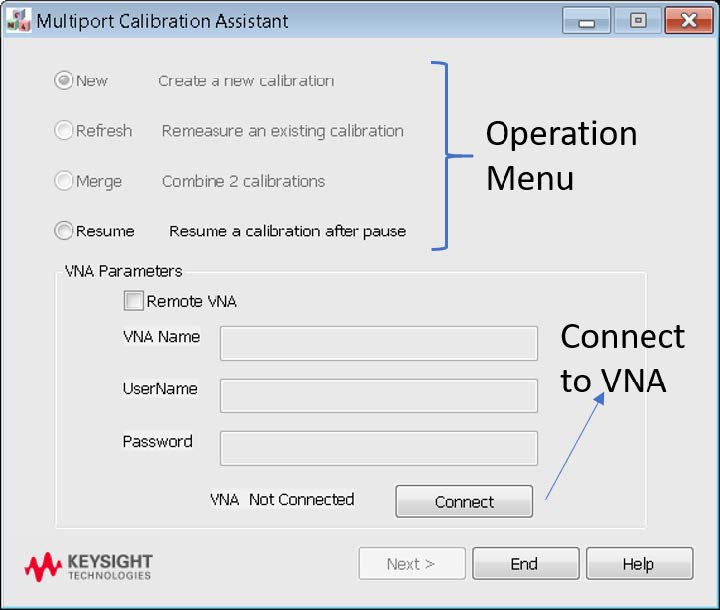
The main page dialog opens once the application starts and it’s used to select the operations to perform and to connect to the VNA.
VNA Connection
The first operation to perform is the connection of the application with a VNA. If the application runs inside a VNA pc the simple press of the Connect button on the main page activate the connection, otherwise a remote VNA can be use provide that:
1. The user has the proper access right on the remote VNA.
2. DCOM is installed and run on the remote VNA.
3. The DCOM permission for the application is given.
Once these conditions are achieved the user must insert
1. VNA name as it's network name or IP address
2. User Name
3. Password
on the main dialog and then press the Connect button. Once the connection is established the operation menu comes alive and the user may select one of the following operations, described in the following sections:
1. Perform an unguided multiport calibration.
2. Refresh an existing multiport calibration.
3. Merge two different calsets.
4. Resume a calibration which was previously paused.
After selecting an operation user must press Next to proceed.
New Calibration Setup
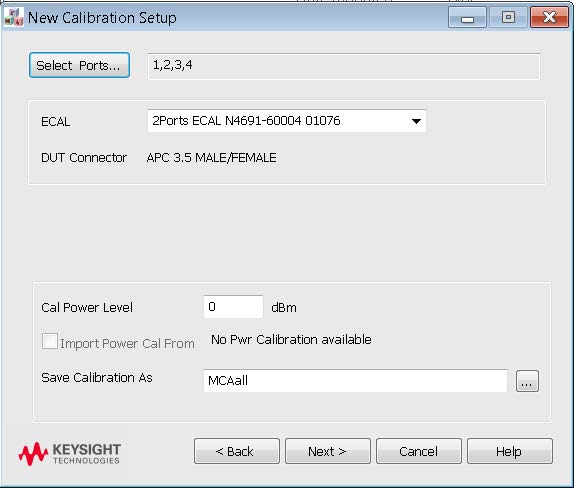
The New Calibration Setup allows a fast configuration of a new multiport calibration. Here you can select all the fundamental parameters required to perform an ECAL based VNA calibration, such as:
1. The ports to be calibrated.
2. The ECAL to be used.
3. The calibration power level.
4. The calset name.
Select Ports Open the select calibration ports dialog below. User can select the ports which will be calibrated.
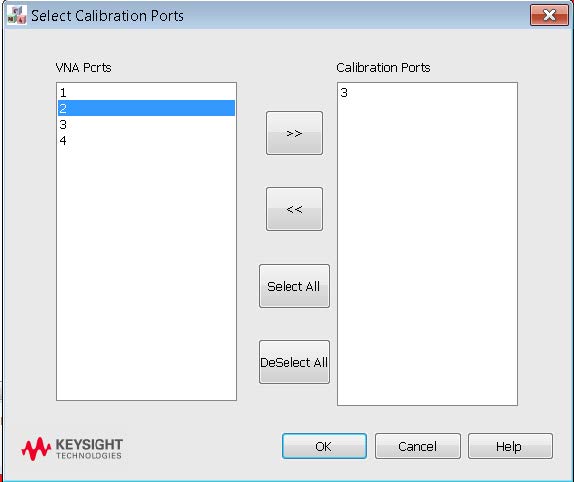
User can select the proper VNA ports which will be calibrated.
Once the calibration ports are selected, the user pick up an ECAL from the ECAL combo box which shows the available unit. If there are no ECAL attached, an error will be thrown, and the software will not be able to perform any operations which requires a measurement. If more than one ECAL is available, the user can select the one to be used. Two ECAL cannot be used during the same calibration. If two ECAL are required then two calibrations could be done. So user can use the merge feature to obtain a unique calset.
DUT Connectors
Once the ECAL is selected the DUT connector box is automatically update. The software assumes a predefined sequence for the port connectors which are x by the ECAL. When the ECAL is a Male-Female the software assumes that:
With n ports:
- The odd ports number are male.
- The even parts number are female.
- We can connect any female with any male ports.
This rule allows to easily setup a standard connection sequence based on consecutive connection of odd-even port number as shown in figure below.
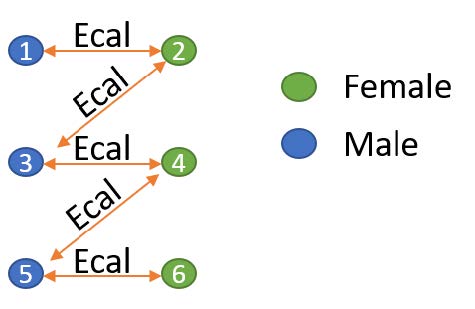
In all other ECAL connector cases,ie all Female or all Male, the VNA ports are assumed to have a matable connector to the ECAL ports and again a simple connection sequence can be apply as shown in figure below.

If more complex configuration of ECAL and VNA connectors are required, then user has to use the standard GUIDED Cal.
This simple port connection scheme minimized the possible mistakes which may occur during a multiport calibration as: connection of the wrong port, cable loosing on a port or bad connector. This is because each port is used in connection with maximum two other ports thus if that port has connection mistake at worst only 3 ports need to be refresh.
Cal Power Level edit box, user can insert the desired calibration power level.
Save Calibration As edit box allows user to set the name of the error coefficient calset. User can select a different calset from the one already available by pressing ... button.
Power Calibration
MCA does NOT perform a power calibration in the multiport case, however it allows to use an already available calset which contains power coefficients of at least ones of the selected calibration ports and use this calset to generate a multiport power calibration. This new features is available only when a compatible power calset is available, ie a calset which has at least one of the port selected for the calibration with power coefficient and with the same frequency set. Once this condition occurs the Import Power Cal From check box becomes active and once selected, the user can choose which calset used to renormalized the new calset produced by MCA.
The Next button opens the ECAL measurement dialog.
ECALs Measurement Dialog
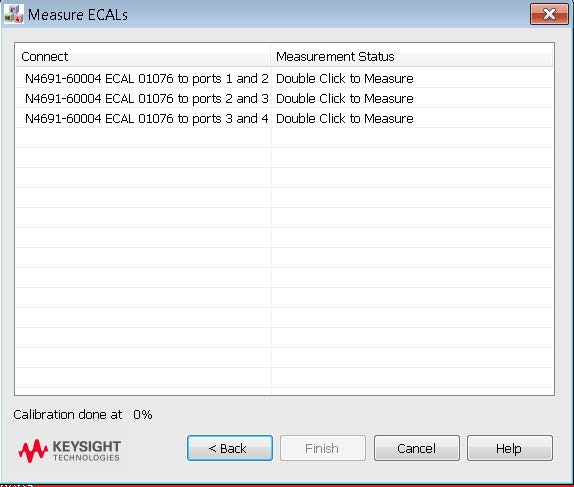
User can acquire the required calibration measurement in any order by double clicking on each entry of the standard list. Each acquisition can be redone at will, while if at least one ECAL has been acquired, the Pause-Finish button comes alive.
Pause Pause the acquisition if at least one measurement is missing.
Finish Finish the procedure and compute the coefficients if all the measurements have been acquired.
The pause feature saved all the measurements done up to now and brings the user back to the main menu where the resume feature allows to return to the measurement page to acquire the missing items.
Back Returns to the main page discharging all the acquired measurements.
Merge Calset Dialog

User can combine two different calsets into an unique one.
Once the sources and destination calset are set by pressing the Apply button the coefficients of the merging are computed and this dialog is closed. In order to be merged the two calsets
To combine the two different calsets, MUST have:
-
Identical set of frequency: start, stop, number of points
-
At least one port in common.
-
The calsets have at least 2 ports each. You cannot merge a one port testset because the one port case has some error term missing in case of that port in conjunction with other ports.
Refresh Calibration
This features allows to refresh a particular calibration,ie a calset, by doing only some of the required ECAL connections. This feature is particularly useful when a multiport vna has been calibrated, but one or more ports look to be o. In this case by the refresh calibration the user can perform a calibration only on the o ports plus one of the others and not on the whole set of ports. This latter ports is used as pivot to connect the error terms of the original calibration with the one done on the refresh and pivot port only.

Refresh Calset Select the calset to be refresh from the drop down list.
Refresh Ports Select the ports to be refresh by clicking on the button.
Common Port Select one port which is NOT to be refresh BUT part of the calset to be refresh which will be used as pivoting.
ECAL Select the ECAL to be used from the drop down list.
Cal Power Level Set the calibration power level.
Next Open the ECAL measurement dialog as in a new calibration. But, the connection will be limited to the refresh and the pivot ports only.
Resume Calibration
The resume calibration features restores the status of a previous paused calibration and brings the user directly to the ECALs measurement dialog with the identical condition in term of measured connections.
This pause-resume feature is useful when a long multiport calibration is performed and the user wish to pause the procedure and it works even if the application is shut down and restart. The feature can restore the status of the pause calibration ONLY IF the user does not erase a special calset created during the pause named pauseresumecalset.
Application Errors
0x1000 Connection Failed Program Aborted
Description: The VNA connection is lost thus the application is aborted. This errors occurs when the VNA application is not running or when the network connection is failed in the case of remote VNA.
Solution: Check the network or that the VNA application is properly running.
0x1001 Connection Failed Check Credential
Description: The user name or password used to connect to a remote VNA is incorrect.
Solution: Check the permissions and the DCOM setting on the remote VNA.
0x1003 No ECAL Available
Description: There are no ECAL connected to the VNA. Without an ECAL the application cannot perform any calibration.
Solution: Verify the ECAL connection.
0x1004 Calset for Storing Already Exist
Description: The calset name choose for storing the calibration coefficient already exist. MCA does not allow to append error terms to already existing calset.
Solution: Change the name for the calset or delete the existing calset.
0x1005 Starting Calibration Failed
Description: The calibration could not being start. This typically occurs when the ECAL and VNA frequencies are incompatible.
Solution: Check the VNA vs ECAL frequencies. If the error persists run an ordinary GUIDED Cal inside the PNA on just one port. This procedure should highlight calibration inconsistency.
0x1006 Initialization Failed Program Aborted
Description: The application failed to initialize the VNA.
Solution: Check the VNA is properly running.
0x1007 No Calset Available
Description: There are no calset in the VNA memory, thus many operation like refresh, resume and merge cannot be accomplished.
Solution: This is a warning. Perform a new calibration to have a calset.
0x1008 Invalid Calsets for merging
Description: The selected calsets cannot be merged because they are incompatible. This may occurs if the calsets do not have at least one port in common or there have different frequencies.
Solution: The merging operation is aborted unless you can select a compatible calset pair.
0x1009 One Calset contains only one port
Description: The selected calsets cannot be merged because at least one of them contains just one port.
Solution: The merging operation is aborted unless you can select a compatible calset pair.
0x100A Calsets with different frequencies
Description: The selected calsets cannot be merged because they have different frequencies.
Solution: The merging operation is aborted unless you can select a compatible calset pair
0x100B Channel Frequencies and ECAL frequencies are not compatible
Description: During a refresh operation the selected ECAL and the channel, ie calset, frequency do not match thus the refresh operation cannot be accomplished.
Solution: Select a compatible ECAL if possible.
0x100C Error Coefficients Arrays empty
Description: The selected calset does not contains error terms thus merge or refresh operations are not possible.
Solution: Select a different calset.
0x100D Channel Frequencies and ECAL frequencies are not compatible during New Calibration
Description: During a new calibration the selected ECAL and the channel frequency do not match thus the calibration cannot be accomplished.
Solution: Select a compatible ECAL or change channel frequencies.
0x100E Query Instruction Failed
Description: This generic error occurs when the VNA failed to answer a MCA instruction.
Solution: Check the VNA error pane,fix the problem by following VNA help instructions and try to re-do the MCA operation.
0x100F Send Instruction Failed
Description: This generic error occurs when the VNA failed to execute a MCA instruction.
Solution: Check the VNA error pane,fix the problem by following VNA help instructions and try to re-do the MCA operation.
0x1010 No Common ports within the calsets
Description: This occurs when the calset used in an MCA operations do not have a common port. As example during the merge a common port must exist.
Solution: Select different calsets.
0x1011 Resume Calset Not Available
Description: This occurs when the automatically generated pauseresumecalset does not exist. In this case the resume operation cannot be accomplished. Typically this happens when the user try to resume without having previously pause the calibration.
Solution: Make a new cal and pause it.
0x1012 Incorrect Resume Parameters
Description: This occurs when the automatically generated pauseresumecalset parameter does not match the MCA resume data. This may occurs because the system became unstable and data corrupted.
Solution: Make a new cal and pause it.
0x1013 Incorrect License
Description: This occurs when the proper license for the application is not installed.
Solution: Contact Keysight support.